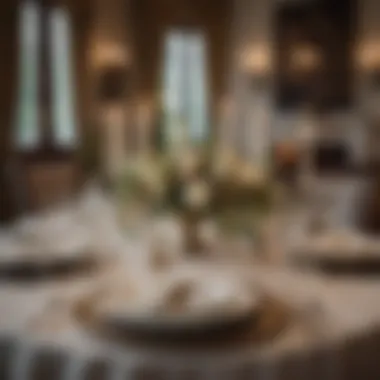Mastering Place Settings: Your Guide to Elegant Dining


Intro
Setting the table may appear to be a simple task. However, it is an art that combines aesthetics with functionality. A well-arranged table creates an inviting atmosphere that enhances the overall dining experience. Whether it's a casual family meal or a formal dinner party, understanding the principles of table arrangement is essential. This guide will explore the components of a proper place setting, the rules of dining etiquette, and practical tips to achieve a refined table arrangement.
In this comprehensive guide, we will discuss various aspects of place settings, addressing the needs of homeowners and design enthusiasts. A holistic understanding of table settings can significantly improve how guests perceive meals and elevate the mood of the occasion.
Home Features
Creating the right ambiance for a dining setting starts well before the table is set. The architecture and design of the home play a large role in determining the overall aesthetic and functionality of the dining area.
Architectural Marvels
When designing the dining space, consider how architectural features can complement the table setting. High ceilings, for example, can make a dining area feel more luxurious. Large windows that allow natural light in can enhance the visual appeal of the meal being served.
Take care to coordinate the table setting with the home’s architectural style. A modern home might benefit from sleek and minimalist designs, while a traditional home could look great with classic tableware. Elements like crown moldings or exposed beams can set the tone for more rustic or elegant arrangements.
Unique Design Elements
Unique design elements should always be considered in the table arrangement. This includes not just the furniture but also the accessories that surround the dining space. Consider using items like a statement centerpiece, which can draw attention and set the theme of the meal.
Choosing materials for the table—wood, glass, or metal—reflects personal style and can affect how formal or casual the setting feels. Beyond just the dining table, also think of how the surrounding elements, such as artwork or even the color of walls, play a part in the overall arrangement.
Interior Design Inspirations
Inspiration for setting a table can be found in various sources, from nature to cultural events. The colors, themes, and textures you choose will ultimately tie into the experience you want to create for your guests.
Color Palettes and Themes
Selecting a color palette is a crucial step in creating an appealing table arrangement. Choose colors that resonate with the occasion. Soft pastels can work well for brunches, while deeper jewel tones enhance the drama of an evening dinner. Use the colors of your dishes and decor to create a harmonious look.
It is also worth exploring seasonal themes. For instance, autumn table settings can incorporate oranges and browns, while spring can use bright greens and yellows to reflect the vitality of nature.
Furniture Arrangement Tips
The arrangement of furniture can directly influence how the table setting is perceived. Ensure that there is enough space around the dining table for guests to move comfortably. Additionally, consider how seating is arranged. A round table may be ideal for conversations among guests.
Furthermore, ensure alignment between the table and other furniture pieces in the room. Cohesion can enhance the aesthetics of the dining area while making it easier to navigate the space during meal times.
"A well-set table is not just about the plates and cutlery; it reflects the essence of hospitality and care."
In closing, mastering the art of place settings goes beyond mere arrangement. It involves understanding the interplay between various design elements and dining etiquette. By carefully considering home features and interior inspirations, one can create a captivating dining experience that celebrates not just the meal, but also the moments shared around the table.
Understanding the Basics of a Place Setting
Understanding the basics of a place setting is crucial in creating a harmonious dining experience. A well-arranged table not only reflects the host's attention to detail but also enhances the atmosphere for guests. This section serves as a foundation for mastering the art of table settings by exploring the core principles that govern how a table should be set.
Defining a Place Setting
A place setting refers to the arrangement of utensils, dishes, glassware, and napkins for each individual at the table. It includes various elements that ensure guests have everything they need for an enjoyable meal. A typical place setting includes a dinner plate, cutlery, glassware, and a napkin. The arrangement is typically orderly, allowing for effortless access to each item while also presenting an aesthetic appeal.
Historical Context of Table Settings
The evolution of table settings traces back thousands of years, influenced by cultural norms and available resources. In ancient civilizations, meals were informal and often eaten with hands. Over time, as societies progressed, so did dining etiquette and the arrangement of table settings. The introduction of cutlery in the Middle Ages marked a significant change, leading to the structured and often elaborate place settings we see today in formal dining environments. Understanding this history can provide context for current practices and enrich the experience of setting a table.
Purpose of a Place Setting
The primary purpose of a place setting is to facilitate a pleasant dining experience. A proper arrangement allows guests to enjoy their meal without confusion about where to find their utensils or glassware. Furthermore, a well-executed place setting can enhance the overall aesthetic of the table, contributing to the ambiance of the gathering. Attention to detail in place settings signals respect for the guests and the occasion, thus elevating the experience for everyone involved.
A carefully arranged table can transform an ordinary dining experience into something special, reflecting the thoughtfulness of the host and the importance of the occasion.
In summary, understanding the basics of a place setting sets the stage for more advanced arrangements. This knowledge not only aids in practical execution but also underscores the significance of creating an inviting and functional dining environment.


Essential Components of a Place Setting
The essential components of a place setting play a crucial role in defining the overall dining experience. They not only serve functional purposes but also contribute to the aesthetic appeal of the table. Understanding these components allows individuals to create an inviting atmosphere that reflects personal style while adhering to etiquette standards. Choosing the right materials and arranging them thoughtfully enhances the dining experience for guests.
Dinner Plate
The dinner plate is the central piece of any place setting. It provides the foundation for the meal and sets the tone for the dining experience. A well-chosen dinner plate can complement the food's presentation and elevate the entire meal. When selecting a dinner plate, consider size, shape, and material. For example, a large, shallow bowl may be ideal for pasta, while a deep plate is perfect for soups. Durability also matters; porcelain and stoneware are popular choices due to their resilience, while glass and ceramic can offer a more delicate appearance.
Cutlery
Cutlery includes forks, spoons, and knives, forming the tools for dining. Each type of cutlery has a specific use, which is important to grasp for any dining setting.
Forks
Forks are essential for most meals. They are designed primarily for lifting food to the mouth but also serve cutting and piercing purposes on softer foods. A common characteristic is the number of tines, which influence their utility. A four-tine fork is standard for many dishes, making it a versatile option. Their balance and weight play pivotal roles in comfort during use. However, too heavy a fork can cause fatigue during longer meals and may impact dining enjoyment. Using quality forks ensures a pleasant experience.
Spoons
Spoons serve multiple functions, mainly for liquids and softer foods. They come in sizes that make them adaptable for various uses. For instance, soup spoons are larger, allowing for better intake of broth, while dessert spoons are smaller for finer servings. The shiny surface of a stainless-steel spoon indicates durability and resistance to tarnish. Choosing the right spoon can affect the meal's enjoyment, as some guests might prefer a rounded spoon for comfort. Care should be taken while using heavier spoons, as they can be cumbersome occasionally.
Knives
Knives are vital for cutting through food efficiently. Each knife has a designed edge tailored for a specific purpose. For instance, steak knives have serrated edges for slicing meat, while butter knives feature blunt edges for spreading. A key characteristic is grip; a well-designed handle provides comfort and ease when cutting through tougher foods. Quality knives do not bend easily, which impacts their efficacy. Nonetheless, overly sharp knives can pose safety risks if not handled properly.
Glassware
Glassware is equally important during dining, comprising water glasses and wine glasses. The right choice enhances the presentation of the beverages and complements the meal's theme.
Water Glass
Water glasses are more than just functional items. Their clarity and shape can impact the perception of water. A wide base and a slightly tapered top help maintain temperature. The material can also affect aesthetics; crystal glass is visually stunning but may chip easily. A heavy water glass can feel substantial in hand, offering a pleasing experience during the meal.
Wine Glasses
Wine glasses come in various shapes, each serving a purpose. The shape of the bowl is crucial for aeration, as it affects the fragrance and taste of the wine. A wider bowl promotes oxygenation, enriching flavors. Different glasses exist for red, white, and sparkling wines, allowing for full appreciation of the wine's characteristics. A common mistake is using the wrong glass. Ultimately, correct glassware enhances the overall dining experience, making it pleasing and sophisticated.
Napkin
The napkin is often an overlooked element in table settings. However, it serves both practical and decorative purposes. It absorbs spills and keeps guests clean while dining. Material matters; cotton napkins offer a more refined appearance, while paper napkins are convenient and disposable. Folds can add creativity to the table, forming shapes that add visual interest. A well-positioned napkin compliments the dishes and cutlery, enhancing the overall aesthetic.
The Art of Table Arrangement
The art of table arrangement is central to creating a dining experience that is both aesthetically pleasing and functional. It integrates elements such as symmetry, balance, and the appropriate use of space. Mastering this art leads not just to a visually appealing setup but also to a comfortable and inviting atmosphere for guests. Understanding the dynamics of table arrangement helps in expressing the occasion or theme of a gathering, elevating the dining experience.
A well-arranged table can alter the mood of a gathering. It communicates readiness and thoughtfulness to your guests. Incorporating various elements in the right way can ultimately enhance enjoyment. It is essential to consider factors such as the number of guests, type of meal, and the venue. By doing so, one can create an arrangement that suits not only style but also practical needs.
Basic Arrangement Guidelines
Establishing a table arrangement begins with fundamental guidelines to ensure functionality and beauty. The primary aim is to create a space that allows for easy movement and conversation while preventing clutter. Here are some key elements:
- Spacing: Maintain adequate space between settings. Aim for about 24 inches of space per guest.
- Symmetry: It provides visual balance. Arrange plates and utensils in a parallel manner for formal settings.
- Accessibility: Ensure that all necessary items are easily within reach. This includes cutlery, glassware, and plates.
- Height Variations: Use different heights for centerpieces and other decor to create visual interest without obstructing the view.
Formal vs. Informal Settings
Table arrangements differ significantly between formal and informal settings.
- Formal Settings: Typically more structured. For instance, courses may dictate the arrangement, requiring specific placement for each piece of cutlery and glassware. Details are emphasized—such as folded napkins and polished cutlery.
- Informal Settings: These are more relaxed, often allowing personal expression. Guests might mix and match tableware. The focus remains on comfort, making it easier for guests to interact.
Layering Elements on the Table
Tablecloths: A tablecloth sets the foundation of any table arrangement. It adds texture and can dramatically change the appearance of a table. Key characteristics of tablecloths include:


- Fabric choices: Options like cotton, linen, or synthetic blends can influence overall aesthetics.
- Color and pattern: These elements can enhance or detract from the overall theme of an occasion.
- Maintenance: Consider ease of cleaning and durability when choosing materials.
Tablecloths serve as a foundational layer, offering a clean backdrop that elevates everything placed on top. They can introduce warmth and sophistication but may also limit visibility of the table underneath.
Centerpieces: The centerpiece serves as the focal point of any table arrangement. This could range from floral arrangements to decorative vases or candles. Centerpieces impact the overall theme and mood in several ways:
- Visual attraction: A well-chosen centerpiece draws the eye, creating interest at the table.
- Theme enhancement: Color and style can reinforce the theme of the gathering.
- Height considerations: Low centerpieces allow for conversation, while taller ones might add drama but could obstruct views between guests.
A centerpiece can either enhance the dining experience or become a distraction. Careful selection is essential for an effective arrangement.
Additional Considerations for Special Occasions
When mastering place settings, it is essential to consider the context in which they are employed. Special occasions bring unique requirements and expectations, requiring careful attention to detail in setting the mood and ambiance. Each type of gathering has its own etiquette, aesthetic, and functionality that can enhance the dining experience, making it memorable for everyone in attendance. This section will delve into three specific kinds of occasions: casual gatherings, formal dinners, and holiday celebrations, detailing the nuances and essential elements of each.
Casual Gatherings
Casual gatherings focus on comfort and familiarity. These occasions often aim to foster relaxation among friends and family rather than adhere to strict formalities. For such settings, simplicity is key.
Selecting a theme can create a cohesive look. In a backyard barbecue, for instance, using vibrant tableware enhances the outdoor vibe. Each guest might have a melamine plate or reusable cutlery to embody a casual feel.
To consider:
- Table Runners: Use colorful or patterned table runners that complement the decor.
- Centerpiece: A simple floral arrangement or even candles can provide a warm atmosphere without being intrusive.
- Seating Arrangement: Allow guests to choose their spots for a relaxed ambiance. You might simply scatter cushions and blankets for sit-down meals.
Accessories should be accessible, allowing guests to help themselves without the anxiety of overdoing it. This approach reinforces the atmosphere of comfort while still showing attention to detail.
Formal Dinners
Formal dinners represent a significant step up in terms of complexity and elegance. These occasions are often characterized by a stringent adherence to etiquette. Here, even the smallest details matter. Each setting should reflect sophistication and planning.
Elements to consider for a formal dinner setting include:
- Charger Plates: Used beneath dinner plates to add elegance and serve as a visual base.
- Multiple Utensils: Place forks on the left and knives on the right, with dessert utensils above the plate. Each piece should serve a specific purpose.
- Glassware Placement: Ensure wine glasses are positioned according to the order of use, starting from right to left, with water glasses placed above the knives.
The use of linen napkins, beautifully folded, can add to the refinement. A tastefully adorned table can evoke a sense of grandeur, elevating the dining experience.
Holiday Celebrations
Holidays offer an opportunity for creativity in table settings. They reflect cultural traditions and time-honored customs. Personalization becomes vital, allowing hosts to share their family’s unique celebration with guests.
Key considerations for holiday table settings include:
- Seasonal Decorations: Use thematic decorations that resonate with the holiday, such as pumpkins for Thanksgiving or ornaments for Christmas.
- Unique Tableware: Incorporating special dishes that are traditionally used during the holiday can add richness to the setting.
- Family Traditions: Incorporate meaningful items, like heirloom silverware, which can spark conversation and convey history.
Cultural Variations in Place Settings
Understanding cultural variations in place settings is crucial when exploring dining etiquette. Dining practices are highly influenced by cultural heritage. Each culture has unique traditions, materials, and arrangements that enhance the dining experience. Recognizing these differences can elevate one’s ability to set the table appropriately for various occasions, making guests feel comfortable and respected. More than just aesthetics, place settings can convey respect and understanding of different customs.
Western Table Settings
In Western cultures, table settings are often formalized, reflecting a structured approach to dining. A typical Western table setting includes key elements such as a dinner plate, cutlery, glassware, and a napkin.
- Placement: The dinner plate is positioned centrally, with forks to the left and knives and spoons to the right. The arrangement emphasizes a systematic approach.
- Formal vs. Informal: Formal settings might feature additional elements like bread plates or specialty glasses depending on the beverage served.
- Materials: Porcelain plates, stainless steel cutlery, and crystal glassware are common, emphasizing elegance.
This meticulousness demonstrates care for the dining experience, ensuring guests feel valued.
Eastern Dining Practices
Eastern dining traditions vary significantly across regions but often share certain commonalities, such as a focus on communal eating. In many Eastern cultures, such as China and Japan, meals are served family-style, and the setting reflects these practices.
- Shared Plates: Dishes are often placed in the center, allowing diners to serve themselves. This promotes sharing and interaction among guests.
- Chopsticks: Instead of cutlery, chopsticks are commonly used, highlighting the cultural preference for specific eating tools.
- Presentation: The focus is on harmony and aesthetic balance. Even the arrangement of dishes reflects the cultural appreciation for beauty and nature.
Adapting to these practices shows a respect for traditions and enhances the communal dining experience.


Fusion and Contemporary Approaches
Fusion dining combines elements from different cultures to create a unique experience. This modern approach to place settings allows for creativity and personal expression. Key aspects include:
- Eclectic Materials: Using a mix of materials—ceramic plates paired with rustic wooden utensils or vibrant textiles for napkins—adds personality.
- Variety of Influences: Contemporary settings might blend Western and Eastern elements, such as offering both chopsticks and cutlery at the same table.
- Personalization: Tailoring the setting to the occasion or guests adds meaning, whether through themed decorations or culturally inspired dishes.
By embracing these variations and combinations, hosts can create a memorable dining experience that respects various cultural influences while still being modern and engaging.
The nuances of cultural variations in place settings not only highlight diversity but also enhance the overall ambiance of dining.
Practical Tips for a Flawless Place Setting
Setting a flawless table is an essential part of creating an inviting dining experience. Attention to detail enhances both aesthetics and functionality. Practical tips can simplify the process and ensure your arrangements are both elegant and coherent.
Choosing the Right Materials
Choosing materials for your place setting is a foundational step. Each item can reflect your personal style while serving its functional purpose.
Plate Material
Porcelain is a prevalent choice for plates. It is known for its durability and classic appeal. Porcelain plates can handle both everyday use and formal events. They are also microwave and dishwasher safe, making them practical.
The key characteristic of porcelain is its non-porous surface. This makes it resistant to staining. Moreover, porcelain can retain heat well, keeping food warm longer. However, it can be prone to chipping if not cared for properly, which can detract from its elegance.
On the other hand, glass plates offer modern allure. They provide visual transparency, allowing the food's colors and textures to shine. While stylish, glass requires careful handling, as it may chip or break easily. Ultimately, your choice of plate material impacts the overall dining experience by combining aesthetics with practicality.
Cutlery Finish
Selecting the right cutlery finish is just as important. It can significantly influence the visual appeal of a place setting. Stainless steel is a common choice due to its resilience and versatility. The reflective surface of stainless steel can add a touch of sophistication to your table.
A brushed finish, for instance, can reduce fingerprints and smudges, maintaining a clean look. A highly polished finish, on the other hand, can enhance elegance but may require more maintenance to keep its shine.
In contrast, gold or silver-plated options provide luxury but may require special care. The unique feature of such finishes is their ability to elevate the atmosphere of any dining setting. However, they may tarnish over time and need regular polishing.
Timing the Setup
Timing is crucial when setting your table. A rushed setup may overlook critical details. Aim to arrange your table well in advance of your guests' arrival. This allows for adjustments and immediate changes as needed.
Consider the timing of your meal as well. If you are serving multiple courses, plan your setting accordingly, leaving room for each course's necessary plates and utensils.
Understanding these practical tips is paramount in achieving a flawless place setting. From plate materials to cutlery finishes, each choice contributes to the overall dining experience, making it memorable and enjoyable.
Ending: Elevating the Dining Experience
The conclusion of this article encapsulates the essence and significance of mastering place settings. A well-arranged table extends beyond mere aesthetics; it serves a practical purpose in enhancing the overall dining experience. When each element on the table, from the dinnerware to the cutlery, is thoughtfully placed, it communicates respect and consideration for guests. This attention to detail fosters an atmosphere conducive to relaxation and enjoyment.
The Importance of Attention to Detail
Every aspect of a place setting plays a vital role in the dining experience. Small details can have a profound effect on one's perception of a meal. For example, the choice of napkin folding can reflect a host's commitment to creating an inviting environment. In addition, ensuring that all items are perfectly aligned showcases a level of precision and care rarely overlooked by discerning guests. The ambiance created through details can transform a simple dinner into a memorable event.
Critical elements to consider include:
- Consistency: Use matching styles for cutlery and glassware. This creates a cohesive look.
- Cleanliness: Ensure all items are spotless and free from smudges.
- Proportion: The size of the plates and glasses should fit the table size appropriately to avoid crowding.
By cultivating attention to detail, hosts signal to their guests that the occasion is worthy of their finest artistic and culinary efforts.
Creating an Inviting Atmosphere
An inviting atmosphere is a key component that extends beyond the arrangement itself. It involves the interplay of lighting, colors, and even the choice of background music. A dimly lit room can provide warmth and intimacy, while natural light can enhance the beauty of the table setting. Furthermore, a cohesive color scheme can unify the elements on the table, creating a softer, more inviting look.
Several approaches can enhance the atmosphere:
- Table Linens: Selecting neutral or soft colors can create an inviting base.
- Centerpieces: Choose simple arrangements that do not overwhelm the table but add visual interest.
- Lighting: Use candles or soft electric lights to set a relaxed tone.
When all components harmonize, they produce an environment where guests feel welcomed, promoting conversation and connection. Hence, the success of a dining experience hinges on creating not just a meal, but a welcoming, enjoyable event.
"The setting of the table can inspire the tone of the entire gathering, making it essential to get right."
Achieving a beautiful table arrangement is an art. When executed with intention and thoughtfulness, it can significantly elevate the dining experience, enhancing the enjoyment of the meal and nurturing connections among the guests.



